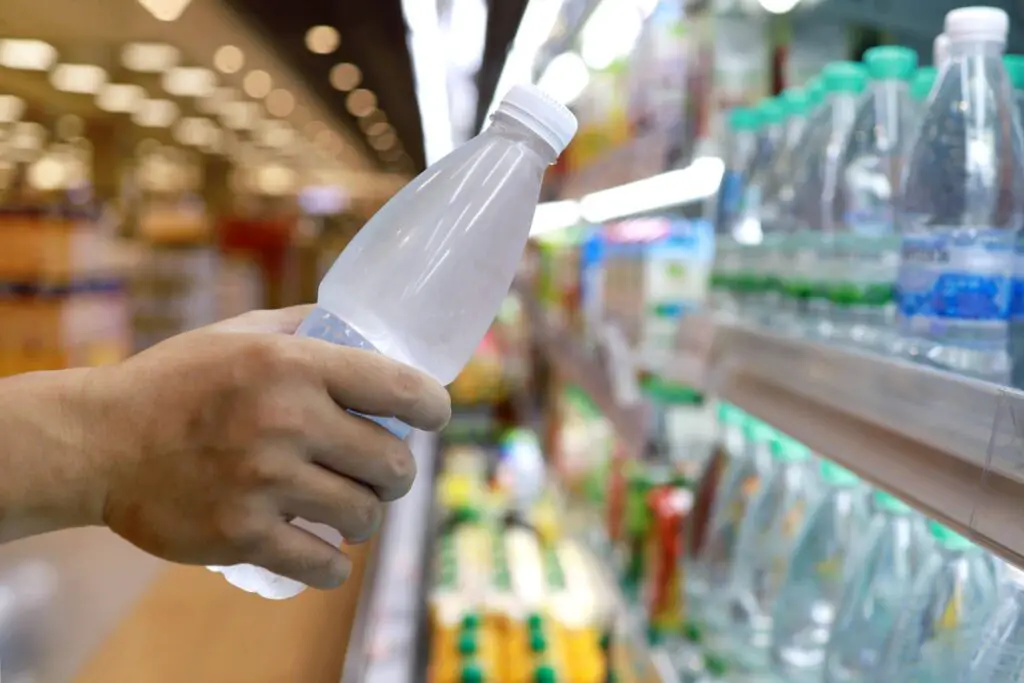Water is essential for life, and with so many options for it these days, it can be tough to know which one is the safest to drink. One popular bottled water brand that you may have seen on store shelves is Aquafina. However, some people have raised concerns about whether or not it’s safe to consume. This blog post will look closer at Aquafina and explore is aquafina safe to drink. Let’s dive in!
Introduction: Aquafina and Its Popularity

Aquafina is a popular brand of bottled water that has gained widespread recognition for its pure, refreshing taste. The water is extracted from artesian wells in Dibba Al Fujairah, an area famous for its high-quality sources. Its factories are located at the foot of the mountainous areas, ensuring the best and purest form of water for its customers.
Aquafina comes in various sizes, including 330ml and 600ml bottles, and is available in packs of 16 boxes. The brand offers a special price of 20 JOD per box for its loyal customers, making it more affordable than other alternatives. It’s no surprise that Aquafina has become a go-to choice for many people who want to stay hydrated throughout the day.
With its refreshing taste, convenience, and affordability, it’s no wonder that Aquafina has gained immense popularity worldwide.
How Is Aquafina Made?
Aquafina is made from local municipal tap water sources undergoing a rigorous 7-step purification process. The process includes filtering, reverse osmosis, and ozonization to remove impurities and create a refreshing, crisp taste. Once the water is purified, it is bottled and distributed to stores and customers by Pepsi Bottling Ventures, which has 20 locations across several states. Aquafina is not just another bottled water brand but a carefully crafted product that comes from a meticulous process to ensure high-quality water tastes great.
So the next time you take a sip of Aquafina, you can be confident that it has been through a thorough purification process, ensuring that it is a top-notch beverage.
Is Aquafina Safe to Drink?
Aquafina is a popular brand of purified drinking water that is available all over the world. Many people wonder whether or not Aquafina is safe to drink, given the concerns about water quality and contamination. According to the available factual data, Aquafina is generally safe for consumption.
However, it is important to be careful about where the water comes from and to be aware of the pH level of the water, which is acidic. While drinking slightly acidic water is not harmful, it may not be the best option.
There are better solutions out there, but ultimately, the decision to drink Aquafina is up to everyone.
The Safety of Aquafina’s Water Source and Production Process
Aquafina’s water source and production process are both safe and reliable. The brand sources its water from public water sources, which are closely monitored by regulatory bodies. The water then undergoes a thorough seven-step purification process, starting with reverse osmosis, to ensure it is free from contaminants or chemicals.
Aquafina takes its water quality seriously and conducts regular sampling and testing of both its source water and finished product to guarantee its safety. The brand’s production process is similar to that of Pepsi, where its water is also sourced from Detroit’s water system, which has been certified by the Detroit Water and Sewerage Department (DWSD).
Overall, consumers can trust Aquafina’s water source and production process as it upholds strict standards to provide safe and delicious drinking water.
Read more:
- Energy Drinks vs. Coffee: Differences in Energy Boosting
- Keeping It Fresh: How Long Are Coffee Beans Good For?
- Is Coffee Good for Sore Throat? The Facts
Controversies Surrounding Aquafina’s Safety
Aquafina water has been a subject of controversy for some time now. While some people swear by its taste and quality, others are skeptical about its safety. The Egyptian Ministry of Health recently ordered the seizure of a quantity of the products of three bottled water companies, including Aquafina, after it was proven that their samples did not conform to the specifications for human use.
Moreover, Aquafina water contains substances that the World Health Organization included in its table of specifications for potable water and its natural properties. However, the company has vehemently denied the rumors that its water is filtered from sewage.
Regardless of the controversies, it is important to remember that Aquafina water is safe for consumption as long as it meets the necessary standards and is properly stored.
Health Concerns Associated with Plastic Bottles and Aquafina
There are some health concerns associated with plastic bottles and Aquafina. According to studies, plastic bottles can release a chemical called bisphenol A (BPA) into the water. BPA is a known endocrine disruptor and can interfere with hormones in the body. While Aquafina claims that their bottles are made without BPA, there are still concerns over other chemicals that may be present in the plastic. Additionally, plastic bottles have also been found to contain microplastics, which are small pieces of plastic that can leach into the water and potentially cause health problems if ingested.
It is important to note that there is no conclusive evidence linking plastic bottles or Aquafina specifically to negative health outcomes. However, limiting consumption and opting for alternative, less disposable options when possible is still a good idea.
FDA Regulations and Safety Standards for Bottled Water

- The FDA is responsible for ensuring the safety and quality of bottled water in the United States.
- The agency has established regulations and safety standards to minimize contamination risks and ensure that consumers trust their bottled water quality.
- These regulations cover all aspects of the bottling process, from the water’s source to the product’s packaging and labeling.
- Bottled water must meet specific limits on contaminants, such as lead and bacteria, and must undergo regular testing to ensure compliance with these standards.
- The FDA also requires that bottled water manufacturers follow good manufacturing practices and maintain detailed records of their operations to ensure compliance with these regulations.
- Consumers can feel confident that their bottled water meets the highest safety standards and has been thoroughly tested for purity and quality.
- Besides regulating bottled water, the FDA also monitors the quality and safety of other food and drug products to ensure public health and safety.
The Effect of Environmental Factors on Water Quality
Environmental factors significantly impact water quality, and understanding these factors is crucial to maintaining a healthy water supply. Human activities, such as agricultural practices and industrial sewage, can lead to water pollution and damage the environment. Leaked fertilizers and pesticides from agricultural areas can affect both surface and groundwater quality. On the other hand, industrial sewage contains heavy metals, acids, and salts that can also harm water quality.
Environmental monitoring is necessary to control the impact of these activities on water quality. In addition to this, careful monitoring of water sources is essential to ensure that the water used for drinking is free from harmful microorganisms and chemicals. To improve water quality, countries can adopt environmental policy standards, such as monitoring and treating wastewater.
Everyone can play their part in protecting the environment and ensuring that water quality is maintained for the benefit of all.
Alternatives to Aquafina Bottled Water
There are several alternatives to Aquafina bottled water for those who are looking to reduce their plastic waste and have a more eco-friendly lifestyle. One option is to invest in a water filtration system for the home, such as a pitcher with a built-in filter or a countertop filtration system.
This can be cost-effective in the long run and eliminates the need for single-use bottles altogether. Another option is switching to a different bottled water brand that is packaged in more sustainable materials, such as boxed water, glass bottles, or aluminum cans. It’s also worth considering carrying a reusable water bottle instead of using single-use plastic bottles.
Individuals can greatly impact the environment and reduce their plastic waste by making these small changes.
Alternative Options for Safe Drinking Water
Various options are available for obtaining safe drinking water, especially in emergency situations evolving with technological advancements. Plastic alternatives, such as high-density polyethylene and polyvinyl chloride, are commonly used in the design of water distribution systems. Home water purifiers are also available in different types, designed to help individuals reach clean and safe drinking water. Innovative endeavors like the EaumOb, which delivers 300 to 1000 liters of drinking water in a manual pumping hour, are also popular choices.
Ultrafiltration membranes remove bacteria, microbes, and suspended particles from the water. Although not a substitute for obtaining safe drinking water, one to two liters can also be filled in clean containers and exposed to sunlight through solar energy. Furthermore, there are innovative endeavors to obtain water “from the air,” which will quench the thirst of regions without safe drinking water alternatives.
With technological advancements, options for obtaining safe drinking water will continue to evolve, relying increasingly on groundwater and alternative sources.
Considerations for Safe Drinking Water.
Regarding emergency preparedness, ensuring access to safe drinking water is the top priority. In a disaster or emergency, taking steps to prevent disease from contaminated water is important. This includes using cold water for drinking and cooking and only obtaining water from sources that meet quality standards. It’s also crucial to never run generators indoors as the engine emits deadly carbon monoxide.
After the disaster, if the treated water has a strong chlorine taste, letting it stand exposed to air for a few hours or pouring it from one clean container to another several times can help improve its taste. Additionally, infrastructure and WASH activities should enable increased frequency of hand washing by increasing population access to soap and expanding access to safe drinking water.
By implementing safe practices, families and communities can protect themselves from potential health risks associated with unsafe drinking water.
FAQ
Q: Is Aquafina safe to drink?
A: Yes, Aquafina is generally safe to drink. Purified drinking water exceeds the contaminants available from the Safe Drinking Water Hotline.
Q: Is it true that Aquafina has an acidic pH level?
A: Yes, when tested, Aquafina came up acidic. However, it is not harmful to drink slightly acidic water, as we commonly eat slightly acidic foods.
Q: What are the benefits of drinking Aquafina water?
A: Drinking Aquafina water can be beneficial as it hydrates the body and provides vital minerals and nutrients.
Q: Are there any harmful contaminants present in Aquafina water?
A: Aquafina water is tested to exceed the contaminants from the Safe Drinking Water Hotline. However, being cautious about where your water comes from is always recommended.
Q: Can drinking Aquafina have any negative effects on health?
A: Drinking Aquafina water has not been linked to any negative health effects.
Q: Is it better to drink Aquafina over soda?
A: Yes, drinking water, including Aquafina, is exponentially better than soda for hydration and overall health.
Conclusion: Should You Drink Aquafina or Not?
In conclusion, the question of whether Aquafina is safe to drink is one that many people are curious about. While there have been concerns in the past about the source of the water and the production methods used by the company, Aquafina has consistently met FDA regulations for bottled water. Buying Aquafina or any other bottled water brand is up to you as a consumer. It’s important to stay informed and make choices that align with your personal values and priorities. Thank you for reading, and as always, drink plenty of water!
References

James Robinson loves coffee and blogging all about coffee. His blog is full of informative posts about the best ways to enjoy coffee and the many different types of coffee out there. He also shares recipes for delicious coffee-based dishes, and his followers can always count on him to offer tips on how to improve their coffee-making skills.
